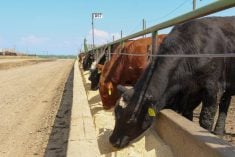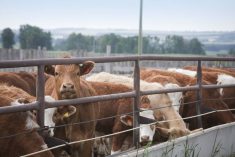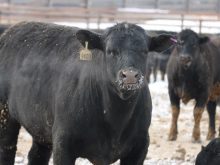Fed and feeder cattle prices have been percolating higher throughout the winter and early spring. Lower-than-anticipated beef production along with steady consumer demand drove fed cattle prices to record highs in Canada and the U.S. Alberta packers were buying fed cattle in the range of $145/cwt to $146/cwt in early spring, which is approximately $12/cwt above break-even pen closeout prices.
Healthy feedlot margins and lower feed grain prices spilled over into the feeder cattle complex. It was not uncommon in early April for quality 700-pound steers in the Lethbridge region to trade near the magical $200/cwt level.
Read Also

Harvest wraps up and fall work begins
At the Eppich famly ranch in western Saskatchewan, the fall harvest was successful with few breakdowns, cows and calves have been sorted and a new tractor has arrived
It has been a rosy situation, but looking forward, it appears most of the factors that resulted in higher prices are starting to change. Fed and feeder cattle markets will soften into the summer period.
U.S feedlot inventories as of March 1, 2014 were basically the same as year-ago levels while placements during the first three months of 2014 were approximately 10 per cent higher in comparison to last year. I’m expecting the weekly slaughter pace to increase during the second quarter and beef production has potential to be the same as in 2013. While Canadian fed cattle prices held value into April, prices in the U.S. southern plains are starting to soften and wholesale beef prices also showed their first signs to breaking the upward trend.
- From the Canadian Cattlemen website: Klassen: Fresh historical highs sum up feeder market
All about packaging
Most farmers realize grocery stores sell packaging, not food. The costs included in packaging such as plastic or wrapping, labour and transportation are more valuable than the food product inside the package. For example, the price of mustard seed on farm could double and consumers wouldn’t notice a price increase for mustard products on the retail shelf.
However, the economics differ for beef in that the actual product composes a larger portion of the final cost. Therefore, as U.S. beef production increases in the second quarter, Canadian exports of processed beef to the U.S. will have to be priced competitively into the market. U.S. country-of-origin labelling has potential to have a larger effect on Canadian prices in a declining market and cattle producers could experience a wider basis on Canadian fed cattle prices.
Cattle inventories in Alberta and Saskatchewan have been running 10 per cent above year-ago levels this spring. The function of the Canadian fed cattle market will be to encourage demand from current price levels.
Restaurant spending tends to peak in late March and early April and then soften into the summer. Fed cattle prices generally follow this consumer spending pattern. U.S and Canadian economies have experienced a robust first quarter with solid growth. However, equity markets generally trend lower during May and June and this selling pressure spills over into the cattle and beef complex. At-home food spending and away-from-home food spending is projected to ease from April through July, which will result in softer beef prices.
Retail beef prices are now at record highs, which has tempered consumption, especially for higher-end cuts. Therefore, as beef production increases in the second quarter, consumers spending will ease and the overall economics will result in softer prices for fed cattle. I’m not saying the market will fall out of bed, but I think the highs are in place and wouldn’t be surprised to see an $8/cwt drop in Alberta fed prices by late June.
Back to break evens
The recent rally in fed cattle prices has outpaced the feeder market. The breakeven values for the summer period are in the range of $131/cwt to $134/cwt. If the fed cattle market comes under pressure as expected, feeding margins will be hovering around breakeven. However, barley prices in southern Alberta were trading at $194/mt, which is up from the January lows of $155/mt. The USDA is forecasting a year-over-year decline in corn acres and in Western Canada, barley acres have potential to be down 10 per cent. Barley prices are expected to strengthen into the summer and the feed grains complex will be extremely sensitive to weather.
The corn market has potential to incorporate a risk premium due to the uncertainty in production during the pollination period, which will cause feed grain prices to be become very volatile. Softer fed cattle prices during the summer along with higher feed grain prices will weigh on feeder cattle values.
Looking at past history, cow-calf producers need to experience one full year over record-high prices before the cattle herd moves into full-fledged expansion. I’m only expecting to see the beginning of heifer retention on a larger scale next fall. Also, the first quarter of 2015 will be the period that the feeder cattle market will actually adjust for lower supplies due to heifer retention. One caveat is if grain and oilseed prices move higher due to lower production this spring. Stronger feed grain prices and adverse pasture conditions tend to delay any expansion activity.















